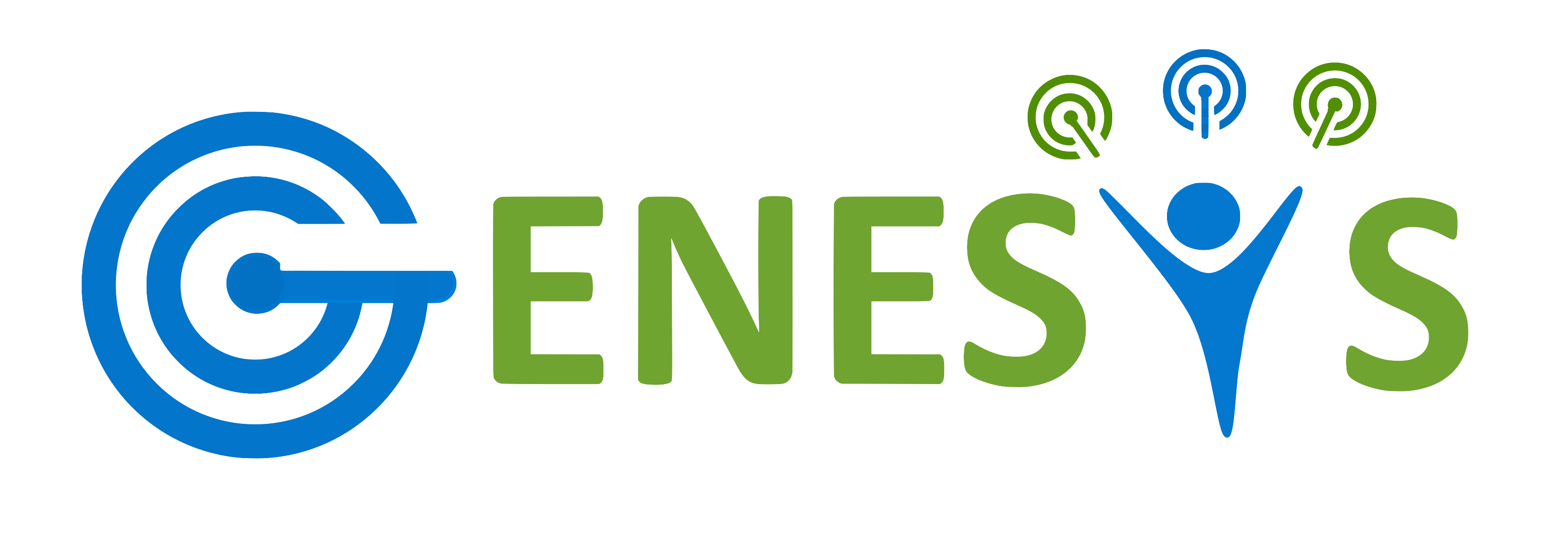



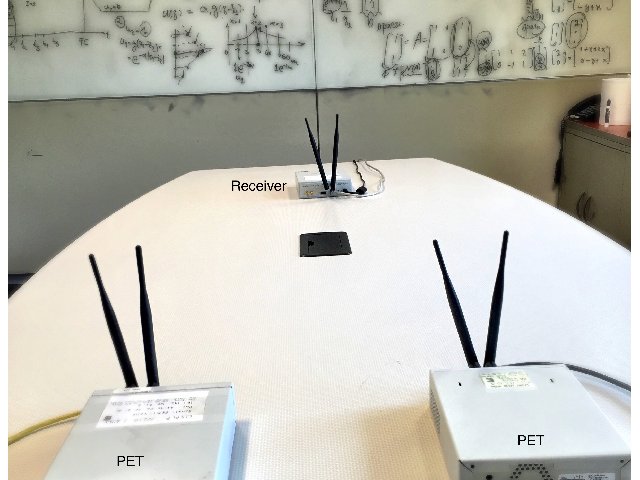







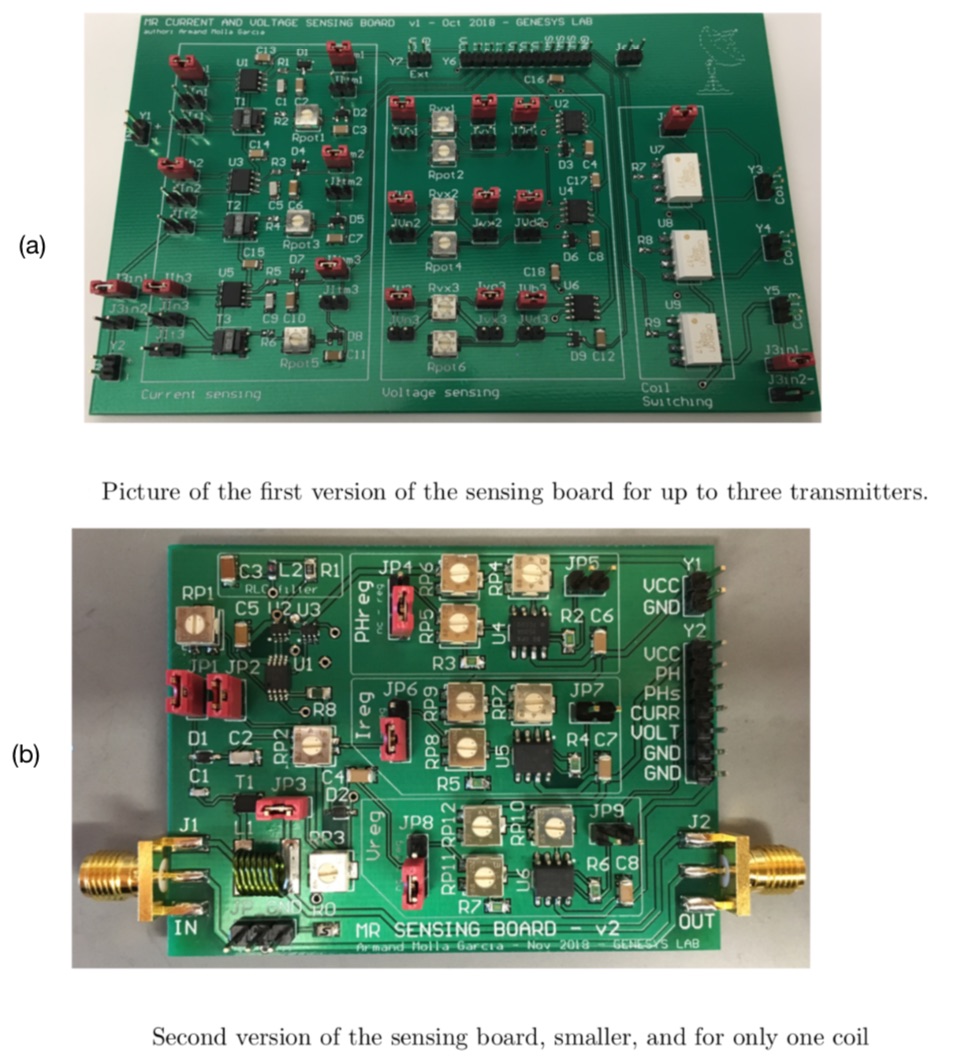
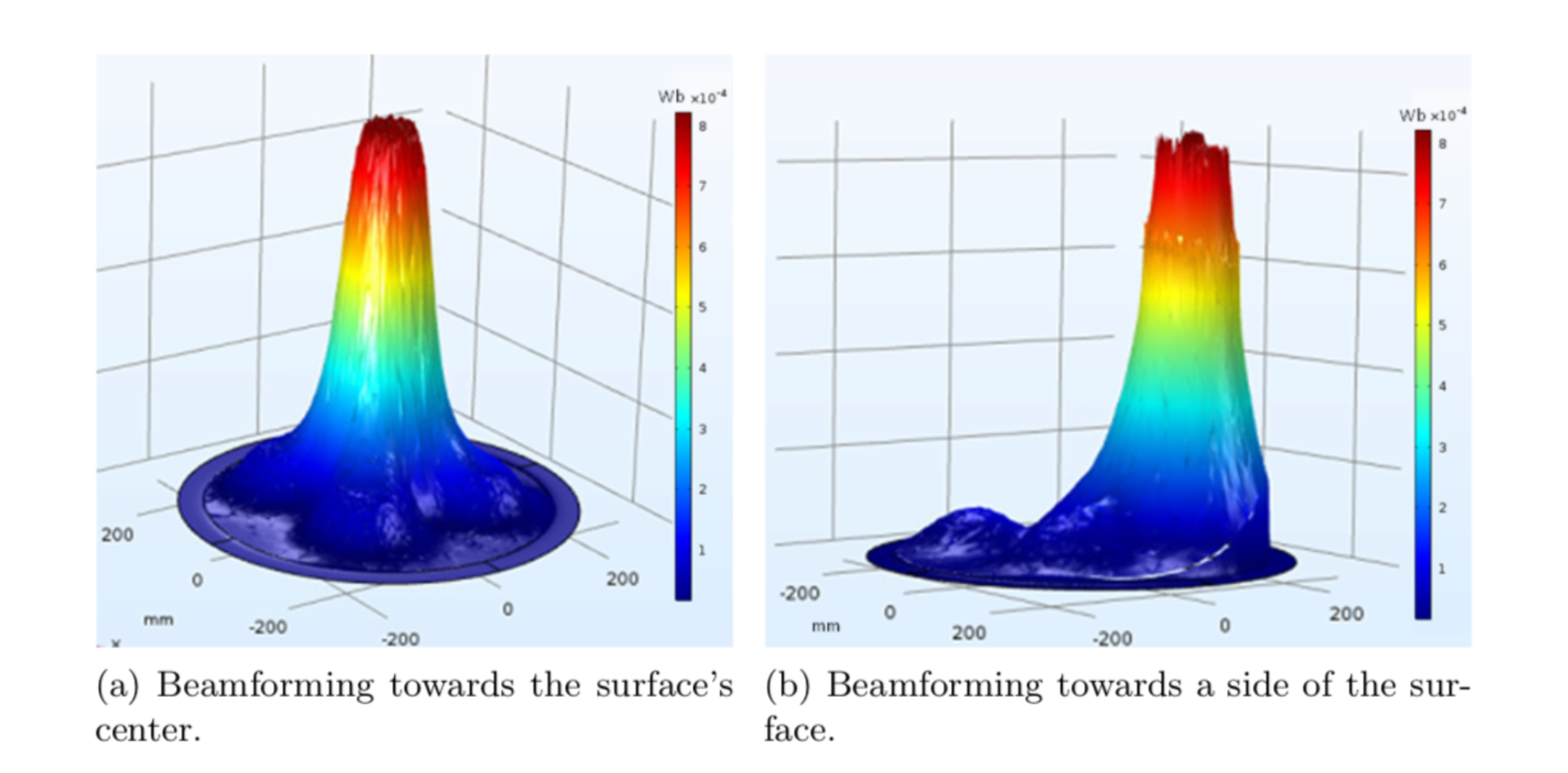
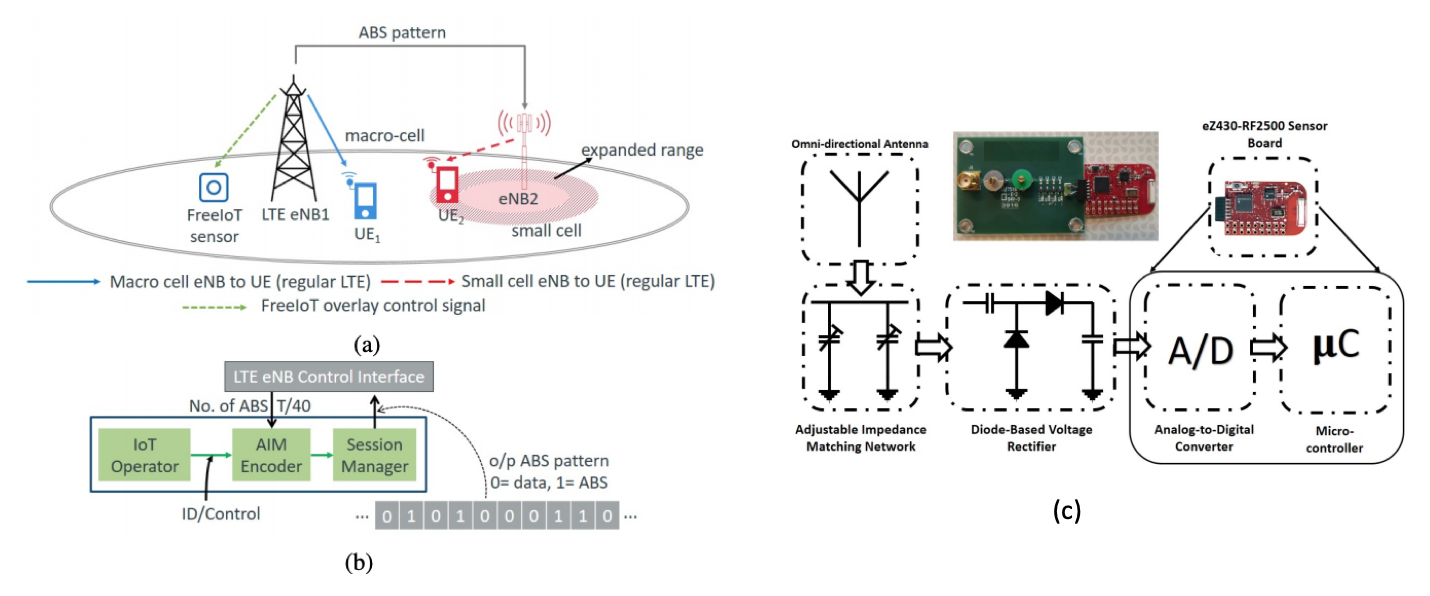
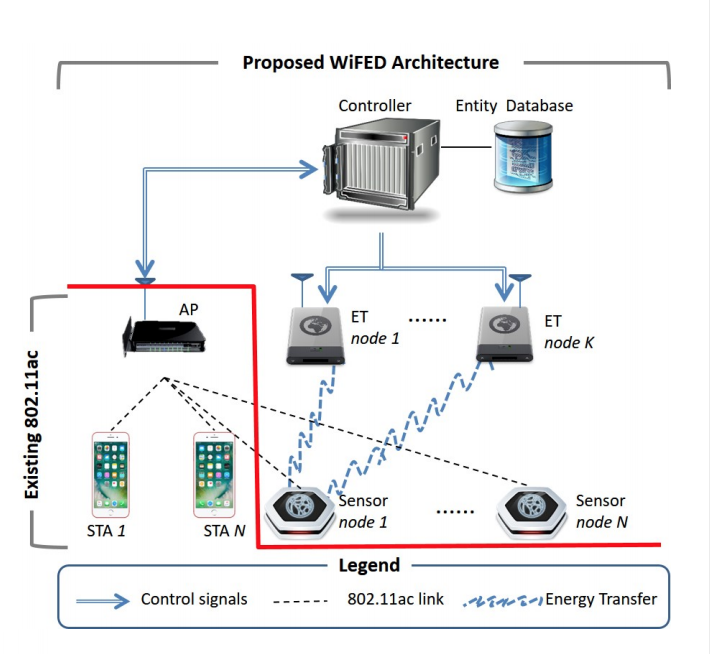

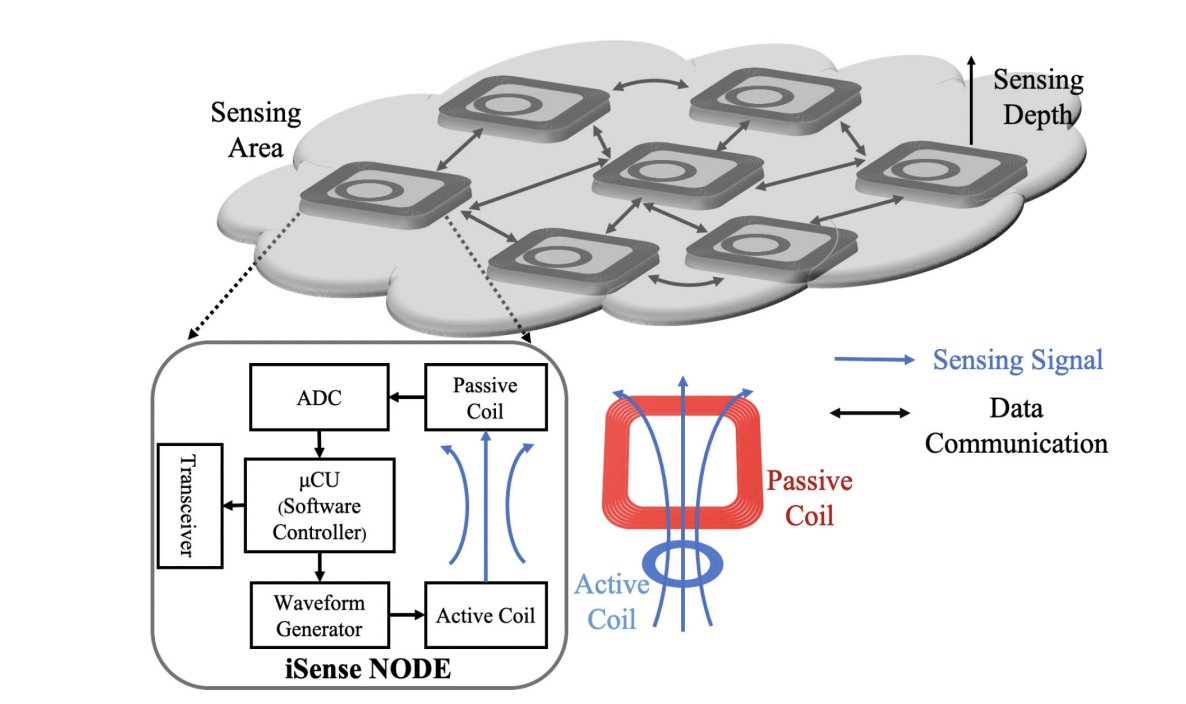
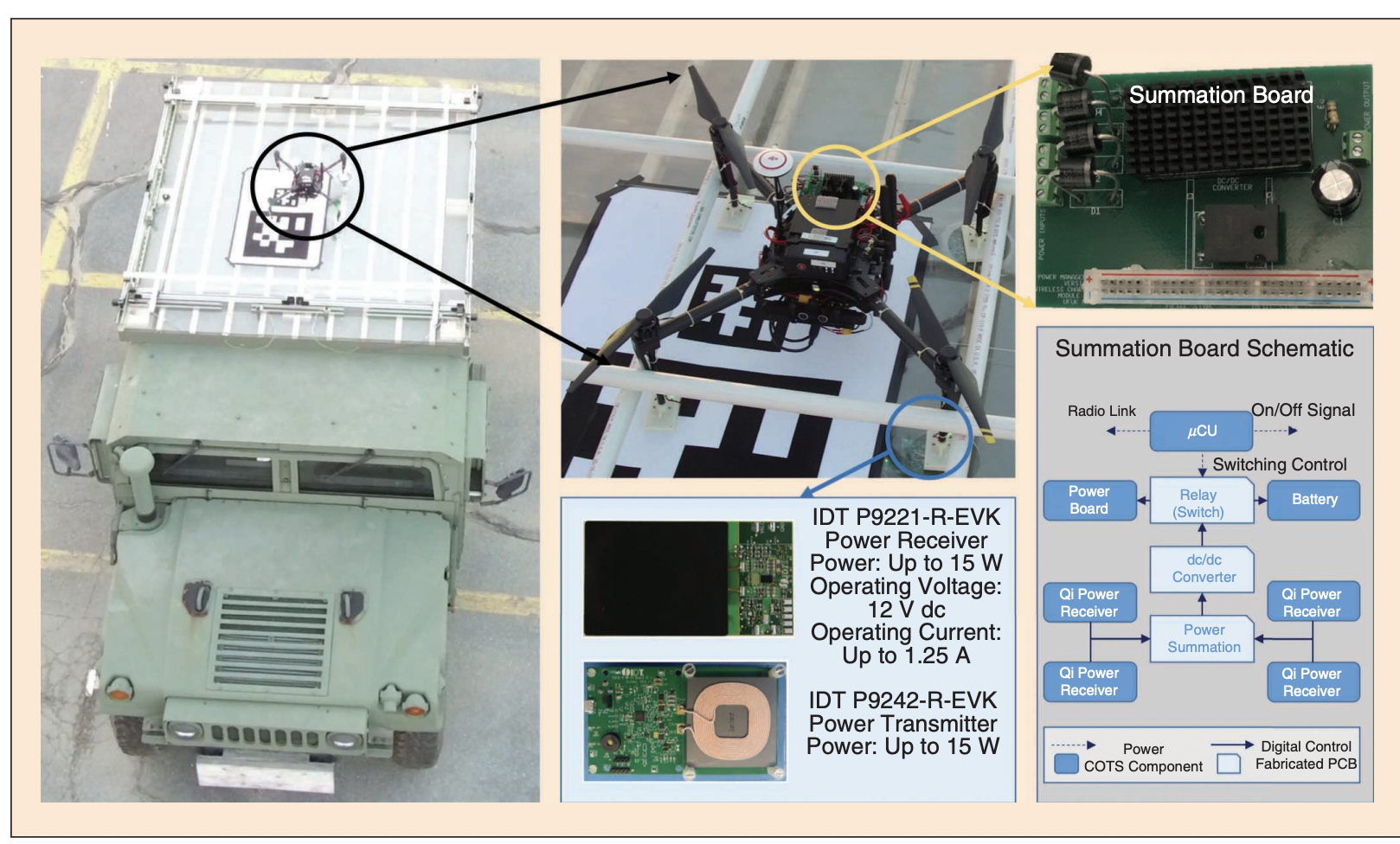


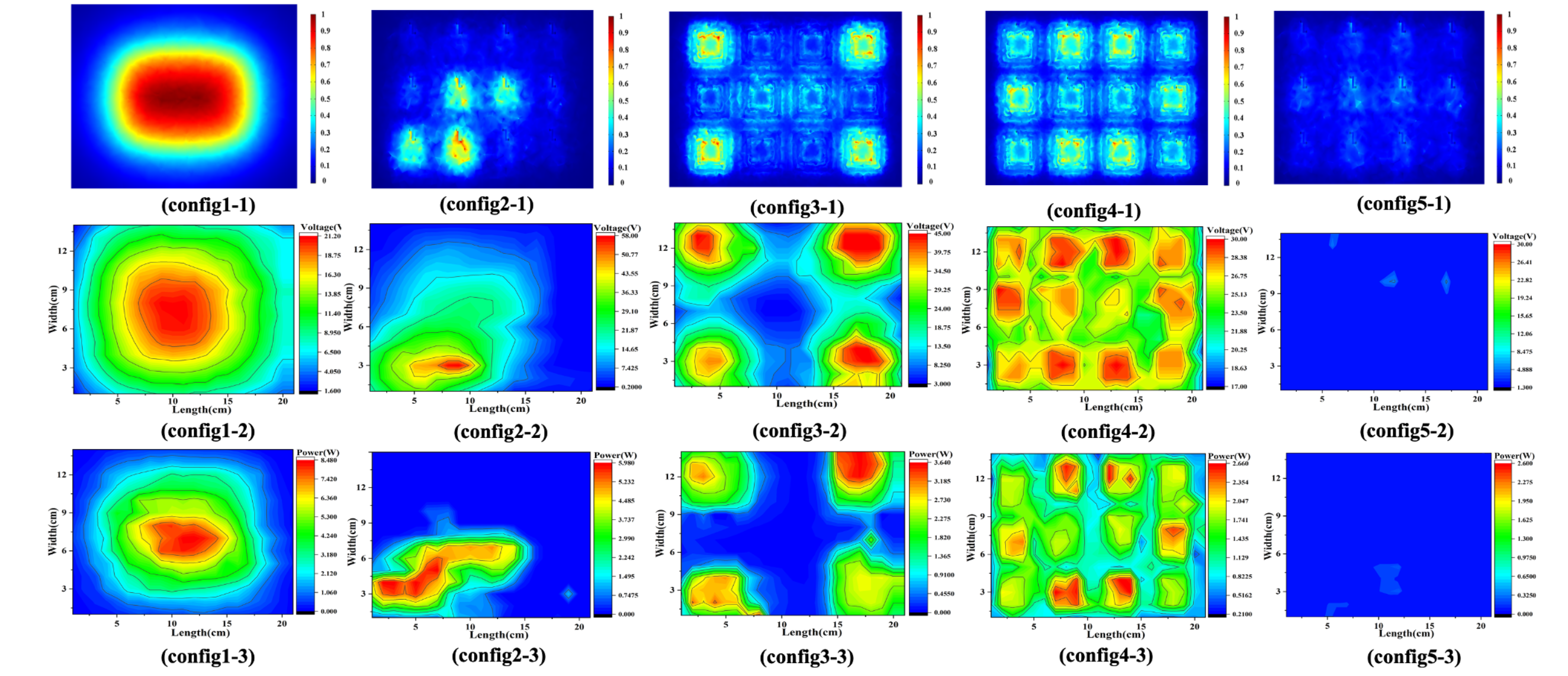

- 05 Apr, 2015
- Current Projects
Project Description
IDEA: Integrated Data and Energy Access for Wireless Sensor Networks (April 2015 - December 2021)
-
Client:
Project Sponsor- NSF
Key Intellectual Merits Broader Impacts Technology Commercialization
Project Personnel:
Yousof Naderi
Ufuk Muncuk
Kai Li
Kubra Alemdar
Raul Cid-Fuentes
Luiza Pelucio
Zachary Deschaux
Kunal Sankhe
Subhramoy Mohanti
John Allen
Project Objectives:
- We will research methods for sharing the channel for the charging and data communication functions in the network, while addressing the challenges posed by phase variance and the constructive and destructive interference of energy signals in space.
- We will propose new routing metrics and protocols for creating energy paths, which will charge only selected sensors to ensure data delivery to the sink occurs timely over these pathways. It will yield concrete insights on the relationship between the number of ETs, their placement, the network lifetime, and the data communication capacity given the energy transfer requests within the network.
- We will answer fundamental questions on how much energy can be obtained through indoor ETs, as well as outdoors from the ambient RF environment in the TV band, leading to the creation of spatial-temporal energy maps.
- We will transform the concept of RF harvesting sensors to a platform for network deployment through a testbed of software-defined radio ETs and circuit designs for RF harvesting boards.
1. Software-Defined Wireless Energy Beamforming:
We developed and demonstrated a software-defined solution for wirelessly charging the sensors using RF energy. Here, the actions of more than one energy transmitter (ET) were synchronized in phase and frequency in realtime using periodic feedback from the target sensor, but without any common clock reference. The controller selected the optimal subset of ETs to satisfy the energy request from a given sensor, which cooperatively beamform RF energy towards that sensor.

Fig. 1. Prototyping distributed energy beamfomring with USRPs.

Fig. 2. Architecture of software-defined energy beamforming.

Fig. 3(a) Network architecture of HYDRA where sensors are powered by joint adhoc beamforming from multiple energy transmitters (ETs) and ambient energy sources.

Fig. 3(b) Average received power density at various locations in the Boston area, from ambient sources as well as when the maximum energy harvesting yield source is intelligently chosen through the so called 'cognitive EH' approach.
Publications:
U. Muncuk, S. Mohanti, K. Alemdar, M Y. Naderi, K. R Chowdhury, “Software-defined Wireless Charging of Internet of Things using Distributed Beamforming," ACM SenSys 2016 - The ACM Conference on Embedded Networked Sensor Systems, Stanford, CA, USA, November 2016. PDF
K. Chowdhury, and M.Y. Naderi, “Distributed Wireless Charging System and Method", Patent No. 62/308298.
2. Simultaneous Wireless Energy Transfer and Communication: When data communication and RF energy recharging occur in-band, sharing the RF medium and devoting separate access times for both operations raises architectural and protocol level challenges. We developed a method of concurrent transmission of data and energy to solve this problem, allowing ETs to transmit energy and sensors to transmit data in the sameband synchronously. Our key idea concerned devising a physical layer modulation scheme that allows the data transmitting node to introduce variations in the envelope of the energy signal at the intended recipient. We implemented a proof-of-concept receiver, modeled and validated through extensive experimentation. We also designed a new physical layer mechanism for guaranteed successful delivery of information in a point-to-point link.

Fig. 4. Energy management functions at the sensor, with the harvested energy budget feeding both the sensing as well as future transmission needs.
R. G. Cid-Fuentes, M. Y. Naderi, S. Basagni, K. Chowdhury, A. Cabellos-Aparicio, E. Alarcon, "On Signaling Power: Communications over Wireless Energy", IEEE INFOCOM 2016, San Francisco, CA, USA. PDF
R. G. Cid-Fuentes, M.Y. Naderi, S. Basagni, K. R. Chowdhury, A. Cabellos-Aparicio and E. Alarcón, "An All-Digital Receiver for Low Power, Low Bit-Rate Applications Using Simultaneous Wireless Information and Power Transmission", IEEE ISCAS 2016, Montreal, Canada, May 2016. PDF
3. Wake-Up Receiver & Token Identification using Energy Harvesting:
The existing passive wake-up receivers (WuRxs) are radio frequency identification (RFID) tag based, which incur high cost and complexity. In this activity, we studied cost-effective and long-range WuRx solutions for range-based wake-up (RW) as well as directed wake-up (DW). In particular, we considered the case of an RF energy harvesting wireless sensor node and investigate how a low-cost WuRx can be built using an RF energy harvester available at the node.

Fig. 5. Prototype of EH-based passive wake-up receiver.

Fig. 6. (a) Touch energy harvester's schematic, (b) PCB design and token’s schematic.
K. Kaushik, D. Mishra, S. De, K. R. Chowdhury, and W. Heinzelman, “Low-Cost Wake-Up Receiver for RF Energy Harvesting Wireless Sensor Networks,” IEEE Sensors Journal, vol. 16, no. 16, Aug. 2016. PDF
P. Nguyen, U. Muncuk, A. Ashok, K. R. Chowdhury, M. Gruteser, and T. Vu, “Battery-Free Identification Token for Touch Sensing Devices, ACM Conference on Embedded Networked Sensor Systems (SenSys), Stanford, CA, Nov. 2016. PDF
4. Medium Access for Energy Transmitters: We researched, what we call a 'Duty cycled random-phase Multiple Access (DRAMA)' scheme, for wireless RF power transmission. Our approach is based not only in handling the interferences of multiple ETs, but also to benefits from them to broaden the input power range of existing energy harvesters at the sensor nodes. For this, DRAMA relies on the fundamental assumption that efficiency is maximized when the input power varies in time as much as possible since the energy harvesters operate with increased efficiency as a function of the input power.
Publications:
R.G. Cid-Fuentes, M.Y. Naderi, R. Doost, K.R. Chowdhury, A. Cabellos-Aparicio, E. Alarcon, "Leveraging Deliberately Generated Interferences for Multi-sensor Wireless RF Power Transmission", in Proc. IEEE GLOBECOM 2015, San Diego, CA, USA, Dec. 2015. PDF
5. Multi-band Ambient RF Energy Harvesting for Self-powered Sensors: We developed a multi-band adjustable circuit for harvesting from LTE 700MHZ, GSM 850MHZ, and ISM 900MHZ bands with one single circuit. To this end, we designed a tunable impedance matching network composed of off-the-shelf components, such as adjustable capacitors (i.e. trimmers) to adapt the impedance matching network configuration with the selected RF band using a single fabricated ambient RF energy harvesting circuit. Our circuit design is fabricated on the printed circuit board with comprehensive evaluations at each associated frequency to test the power conversion efficiency.

Fig. 7. (a) Overview of our adjustable ambient RF energy harvesting system, (b) Prototype of the circuit.

Fig. 8. (a) Battery-free communications setup with TI eZ430-RF2500 sensors that are powered with LTE signals, (b) Levels of average ambient harvested power at different Boston locations.
Publications:
U. Muncuk, K. Alemdar, J. D. Sarode and K. R. Chowdhury, "Multi-band Ambient RF Energy Harvesting Circuit Design for Enabling Battery-less Sensors and IoTs," IEEE Internet of Things Journal, vol.5, no: 4, Aug. 2018 PDF
6. Over-the-air frequency and phase synchronization for energy beamforming. We designed and implemented TX and Rx circuits for real-time over-the-air synchronization called RFClock that is the core enabler of real-time distributed energy beamforming. We designed a Tx circuit that generates a two-tone signal at different frequencies (915 MHz, 925 MHz) separated by desired reference clock frequency (10 MHz). Additionally, we devised the Rx circuit that is capable of extracting the 10 MHz from the two-tone signal transmitted over the air. The received signal is then amplified by using low-noise-amplifier (LNA) without significantly degrading its signal-to-noise ratio. A bandpass filter, filters out the band of the two-tone signal and this filtered signal is divided in two, in order to perform the multiplication step of the signal by itself. The desired reference clock is extracted from the output of the mixer by filtering with a bandpass filter centered at the desired reference frequency. These Tx and Rx over-the-air synchronization circuits enable real-time beamforming with the elimination of on-host frequency and phase synchronizations that add significant time overheads.

Fig. 9. (a) Schematic of RFClock, (b) Prototype of the RFClock.
7. Wearable sensor charging with software-defined magnetic resonance-based transfer. There has been increased interest in the use of wearable sensors in everyday activities from hearing aids to the smartwatch. We aimed to leverage the existing surfaces as energy transmitter to charge these sensors and implemented a multi-coils system (both Tx and Rx) for charging wearable sensor using magnetic resonance energy transfer. We first built a software-controlled surface with 27-coils in 1-square foot that has only one power management circuit. This powers any inductive compatible wearable sensor as soon as it place of the surface. Then we built a distributed magnetic resonance beamforming system. In particular, we designed and fabricated a multi-coils current sensing circuit based on 1:1 PFD3215 transformer as shown in Figure 10. The current measured would be the one flowing through a power inductor inserted in series with the amplifier; the transformer acts as an insulator, being connected in parallel with the sensing inductor. Our configuration provides a lower sensor’s equivalent impedance and higher resolutions of the real-time current measurement.

Fig. 10. (a) first (b) second versions of magnetic resonance-based sensing circuits.

Fig. 11. COMSOL-based magnetic flux intensity results for (a) beamforming toward the surface center, and (b) beamforming toward the surface side.
8. City-scale WakeUp Radio Design using LTE Signals. We designed and demonstrated a wakeup radio control plane that allows fine-grained signaling for city-scale IoT deployments without installing any additional infrastructure, and called FreeIoT. We developed a novel encoding scheme that changes the spatial positioning of Almost Blank Subframes (ABS) within a standard LTE frame to convey control information. ABS was originally defined in the standard to allow coexistence between the macro-cell eNB and nearby small cells, which in our system leveraged as a side channel for IoT signaling. In addition, we implemented a session management protocol to maintain contextual information of the control signaling. This allows our system to handle situations where the control message may span multiple frames, or when the LTE operator temporarily reduces the number of ABS. Furthermore, we incorporated an error detection and correction mechanism to counter channel and fading errors. Finally, we demonstrated a proof of concept testbed to validate the operation of our system using a software-defined LTE eNB and custom-designed RF energy harvesting circuit interfaced with TI eZ430-RF2500 sensors.

Fig. 11. (a) LTE network with the eNB and a given small cell, with spectrum sharing through ABS subframes, (b) FreeIoT framework: The control/wake-up information is conveyed by the position of ABS within a standard LTE frame, (c) circuit schematic of FreeIoT receiver.
Publications:
K. Sankhe, U. Muncuk, M. Y. Naderi, and K. R. Chowdhury, "Talking When No One is Listening: Piggybacking City-scale IoT Control Signals Over LTE,'' IEEE INFOCOM 2018, Hawaii, USA, Apr. 2018. PDF
K. Chowdhury, and M.Y. Naderi, "Method And Apparatus For Overlaying City-Scale IoT Control Signals Over LTE Cellular Networks." Patent No. 62/577,509.
9. WiFi Friendly Energy Delivery with Distributed Beamforming. High power radiation within the ISM band interferes with the packet reception for existing WiFi devices. We devised the first system that merges the RF energy transfer functions within a standards compliant 802.11 protocol to realize practical and WiFi-friendly Energy Delivery (WiFED). We designed and implemented a software-defined architecture composed of a centralized controller that coordinates the actions of multiple distributed energy transmitters (ETs), and then integrated specific features of 802.11 within sensor control plane for requesting and monitoring energy. Additionally, we devised a controller-driven bipartite matching-based algorithmic solution that assigns the appropriate number of ETs to energy requesting sensors for an efficient energy transfer process. We demonstrated our WiFi-friendly distributed energy transfer through a practical system in software-defined radio testbed and extensive simulations.

Fig. 12. WiFED architecture for energy delivery with distributed beamforming over the existing 802.11ac network.
Publications:
S. Mohanti, E. Bozkaya, M. Y. Naderi, B. Canberk and K. R. Chowdhury, "WiFED: WiFi Friendly Energy Delivery with Distributed Beamforming,'' IEEE INFOCOM 2018, Hawaii, USA, Apr. 2018. (best paper award) PDF
10. Collaborative and Distributed Sensing and Tracking of IoT and Electronic Devices Using Networked Coils: Device sensing and tracking using electric and magnetic fields allow intelligent interaction, automation, and adaptation based on location devices and for optimal recharging. We have designed and developed an approach call SoftSense that is uses a software-defined collaborative sensing approach and allows detection of the type of object and where it is placed on a large surface. Unlike RF based sensing approaches that are generally dependent on channel conditions, capacitive sensing that detects only low conductive devices, and Qi-based inductive sensing that is effective at few mm in range, SoftSense has designed to operate without the above limitations and no direct feedbacks from the device. The architecture is cost effective, low power, and scalable, which allows extension over large surfaces. We have introduced a dual-coil inductive sensing architecture based on nested coils, i.e., passive (outer) and active (inner) coils, for low-power contact-less sensing. A data driven approach combined with a support vector machine have helped to classify different materials using the voltage readings obtained at the passive coil. SoftSense has combined sensed voltage information from multiple different coils spread over the surface for collaborative sensing. Additionally, we have validated our design on a real sensing prototype with customized coils, fabricated sensing circuit, and a network software controller.

Fig. 13. System overview of iSense nodes and network with low-power distributed sensing over surface and distance.
K. Li, U. Muncuk, M. Y. Naderi, and K. R. Chowdhury, "iSense: Intelligent Object Sensing and Robot Tracking through Networked Coupled Magnetic Resonant Coils", IEEE Internet of Things Journal 8 (8), 6637-6648, 2021. PDF
K. Li, U. Muncuk, M. Y. Naderi, and K. R. Chowdhury, “SoftSense: Collaborative Surface-based Object Sensing and Tracking Using Networked Coils,” IEEE Globecom 2019, Waikoloa, HI, USA, Dec 2019. (best paper award) PDF
11. Multi-UAVs Wireless Charging Pad with Autonomous Power Delivery: We designed and prototyped an induction-based portable charging and landing pad for unmanned aerial vehicles (UAVs), which supports multiple UAVs at once with wireless charging capability anywhere on the pad surface. This solution is capable of generating up to 150W and is compatible with a variety of drone models (e.g. DJI, Intel, and Yuneec), requiring only a one-time hardware ‘backpack’ installment onto the UAV. We also implemented autonomous power delivery that enables UAV charging while it is on, increasing UAV runtime efficiency and minimizing human involvement.

Fig. 14. The UAV charging infrastructure, onboard power management fabricated circuit, and schematic. PCB: printed circuit board.
Publications:
A. Trotta, U. Muncuk, M. Di Felice and K. R. Chowdhury, "Persistent Crowd Tracking Using Unmanned AerIal Vehicle Swarms: A Novel Framework for Energy and Mobility Management," IEEE Vehicular Technology Magazine, vol. 15, no. 2, pp. 96-103, June 2020. PDF
12. Software-defined Energy Hopping and Power Delivery Over Large Areas: We have designed and developed a software-defined architecture and system including cognitive energy tiles managed by a software-controller and distributed network process within each energy tiles. Additionally, we have developed a programmable and modulated in-band energy flows mechanism with energy hopping mechanism that can deliver high-power over large surfaces and areas. We devised a control channel where the energy tiles share their updates and run various distributed operations based on type, number, and location of detected devices that need to be charged. Furthermore, we developed a reconfigurable multi-layer magnetic resonance energy harvesting circuit that enables high-power delivery in small size receiver as well as adaptive and adjustable power reception based on the receiver load.

Fig. 15. SoftCharge energy tiles attach on the under-side of a given surface. Multiple number and types of devices, from UAVs to phones, can be charged through energy-on-demand device localization and adaptive energy hopping across tiles.
K. Li, U. Muncuk, M. Y. Naderi, and K. R. Chowdhury, “SoftCharge: Software Defined Multi-device Wireless Charging over Large Surfaces", IEEE Journal on Emerging and Selected Topics in Circuits and Systems, vol. 10, no. 1, pp. 38-51, March 2020. PDF
13. Self-powered Reconfigurable Intelligent Surface with Mobile Object Sensing and Charging: We introduced the first-of-its-kind self-powered reconfigurable intelligent surface (RIS) that can engineer ambient wireless propagation in the environment as well as wirelessly charge multiple devices close to the surface. We developed a resonance coupling power distribution framework that enables arbitrary and configurable power spots and power flow paths over 2D and 3D resonator surfaces to power RIS units and wirelessly charged devices. We designed reconfigurable source and extender resonators and validated the prototype through simulation, experimental evaluations, and real application demonstrations of drone and tablet charging. Additionally, for the surface sensing, we designed and built a group-based interference mitigation scheme based on dividing the coils into two groups, where each group has a different size, and coils are arranged to work together without interference for collaborative sensing. This configuration can adequately mitigate the interference by reducing the mutual coupling between nearby coils.

Fig. 16. Component block diagram for self-powered RIS with reconfigurable RF and power layers.
K. Li, M. Y. Naderi, U. Muncuk, and K. R. Chowdhury, "iSurface: Self-powered Reconfigurable Intelligent Surfaces with Wireless Power Transfer," IEEE Communications Magazine, vol. 59, no.11, pp. 109-115, 2021. PDF
14. Programmable Wireless Charging Platform: We designed and developed a programmatic wireless charging solution development platform consists of four main parts that works together to enable the first-of-its-kind ecosystem for programmable development: (1) software-defined software stack, (ii) a development and configuration software kit with easy-to-use interface that generate configuration files, (iii) reconfigurable wireless charging hardware kits that run the software and change their the wireless charging policies and settings based on configurations files and commands, and (iv) monitoring and management dashboard. Additionally, we developed a programmatic wireless charging solution process that consists of four phases: (1) customize: determine specifications, (2) configure: automatically & programmatically generate configuration files, (3) construct: build & deploy hardware, (4) test: analyze, monitor, & optimize wireless charging solution in real-time.
Publications:
Method and Apparatus for Programmatic Wireless Charging . Patent No. PCT/US2022/0196 . UNITED STATES. Application Date = 03/09/2021 .
15. Holographic Beamforming via Reconfigurable Intelligent Surfaces: We designed and developed a magnetic resonance-based wireless power transfer system with a metasurface layer, which reshapes the magnetic field through it that results in ‘MetaResonance’. The advantages of MetaResonance over conventional methods lie in its ability to firstly provide high-power delivery with safety guarantees, customized power distribution profile in three dimensions over the surface, and high end-to-end efficiency. We first provide robust theoretical analysis based on wave reflection and strong coupling theory for redistribution of the magnetic field, and we have simulated and built an experimental setup of the proposed MetaResonance for validation and implementation. Results demonstrate higher magnetic field reconfigurability, higher safety guarantees with more than 95% magnetic field blocking efficiency within 2 cm, and the power transfer efficiency can be improved up to 92.8%. We have demonstrated various real-world charging applications concerning consumer electronics, industrial tools, battery packs, and medical devices.

Fig. 17. MetaResonance creates various configurable energy heatmaps over the surface.
Kai Li, Yousof Naderi, Ufuk Muncuk, and Kaushik Chowdhury (2021). MetaResonance - A Reconfigurable Surface for Wireless Power Transfer. IEEE Transactions on Circuits and Systems. (submitted)
We engaged in building an outreach program, where high school freshmen, sophomores, and juniors get early exposure to engineering in a day-long visit to the NU campus. For this event, we have developed an educational game that runs on the Google Nexus-`S' Android phone. Here, the students search for so-called "radio eggs" spread throughout the campus with the phone, which are actually beacon signals transmitted by pre-selected access points. The phone displays an "egg-found" message only when the signal strength is between -65 to -70 dBm. For lower magnitudes of signal strength, the phone hints at a nearby presence of the egg by changing the color to blue e.g., Bike stand. All identified eggs switch permanently to green with a strike-out. At the end of the activity, students have explained concepts of the exponential fall of signal strength, path loss in the wireless channel, device addressing through beacon exchanges, and factors impacting correct packet reception.

Fig. 18 Various events from interactive demonstrations to educational games.
Source code for Android-based Wifi EggHunt for outreach activity: Download
Additionally, we partnered with Brooke Charter Schools to host 50-60 students for a half-day event with interactive demonstrations, presentations, and discussions with faculty and students. This school system has five branches and academic levels up to K-8 with 94% of the students in attendance being of African-American and Latino backgrounds. Previous demonstrations have included showing wireless signal energy distribution through our RF energy harvesting sensors that are connected to a buzzer. The audio tones indicate how much energy has been harvested at a location, followed by explanations of why tones (and hence, energy levels) differ by location.
Talk delivered at ACM MobiCom.
The years of R&D experience through the NSF CAREER project have resulted in the development of the next-generation software-defined wireless charging platform and DeepCharge startup was officially founded in 2018 for the commercialization of this technology. In time, this technology research won prestigious awards, such as the Presidential Award for remarkable contributions in the area of wireless technology, MassVentures Acorn Innovation award, and Spark Fund, and the team participated in several accelerator programs including the MassChallenge, Roux Institute Founder Residency Program, NSF ICorps, and NYU Creative Destruction Accelerator, and featured in dozens of technology news such as Forbes, Bloomberg, and Yahoo Finance.

Fig. 19 DeepCharge, a successful example of the technology translation from this CAREER project.
